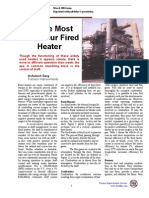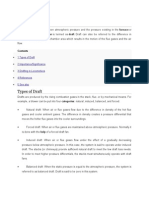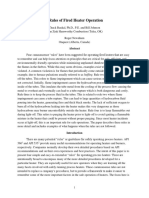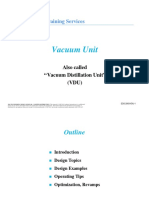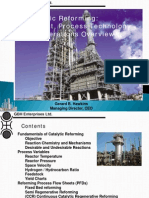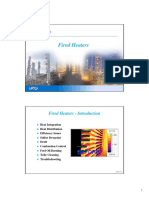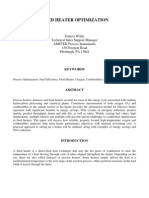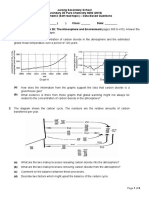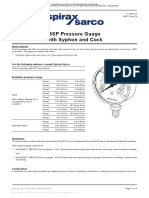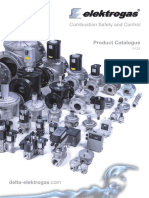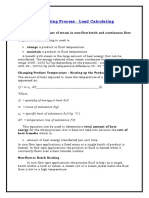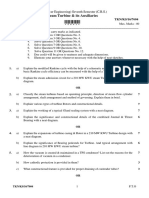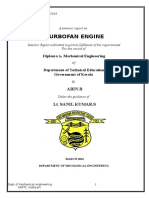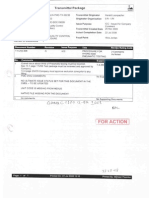Fired Heaters
Fired Heaters
Uploaded by
Ahmad Riaz KhanCopyright:
Available Formats
Fired Heaters
Fired Heaters
Uploaded by
Ahmad Riaz KhanOriginal Description:
Copyright
Available Formats
Share this document
Did you find this document useful?
Is this content inappropriate?
Copyright:
Available Formats
Fired Heaters
Fired Heaters
Uploaded by
Ahmad Riaz KhanCopyright:
Available Formats
Fired Heaters
(Fired Heaters) Page 1 of 40
(Fired Heaters) Page 2 of 40
Contents
Fired Heater Designs
Furnace Equipment
The tubes
Draft Systems
Air Pre-heaters
Burners
Fuel Systems
Performance Monitoring
Excess Oxygen (O2)
Draft
Product Outlet Temperature
Process Flow Rates
Fluid Flow
Stack Temperature
Header Boxes
Pilots
Burners/Flame Patterns
Fired Heater Operation
Furnace Start Up
Furnace Shutdown
Emergency Shutdown
Emergency Operations
Troubleshooting
Flame Impingement
Hot Spots
Coking and Decoking
Soot blowing
Feed Pump Failure
Fan Failure
Valve Failure
Burner Failure
Instrument Failure
Flame Out
(Fired Heaters) Page 3 of 40
Fired Heaters
FIRED HEATER DESIGN
Fired heaters are normally custom designed for a particular application. As a result,
there are many different furnace designs.
Furnace Equipment
Figure 3.4 shows the components of a typical furnace. The burners are located in the
floor of the furnace. Heat is produced by combustion of fuel at the burners. The
open area above the burners is called the firebox. The tubes along the walls of the
firebox receive direct rays of radiant heat. These are called the radiant tubes. The
hot gases formed by burning fuel and air are called flue gases. These gases move up
the furnace and are funneled through the arch into the stack.
Furnace Components
(Fired Heaters) Page 4 of 40
The tubes at the top of the furnace absorb heat from the hot flue gasses passing over
them. These tubes are called the convection tubes.
The section of tubes located between the radiant section and the convection section is
called the shock bank. The shock bank receives both convection and radiant heat.
The furnace walls, floor, and ceiling are lined with a material that reduces heat losses
and reflects heat back to the tubes. This material is called a refractory lining.
Inside the stack is a damper which controls the flow of flue gases out of the furnace.
By adjusting the damper, you can control the furnace draft.
The tubes
The tubes carry the process fluid, or flow through the furnace. The fluid ordinarily
comes to the furnace from other sources that have already raised its temperature to
some extent. It leaves the furnace at a higher temperature.
The furnace tubes are made of metal. The metal tubes absorb heat by both radiation
and convection. The heat passes through the tube walls by conduction. The tube
ends must be joined together to allow for continuous flow through the tubes.
Figure 3.1 Rolled Headers
One way to join the tube ends is with a rolled header (Figure 3.1). The headers are
attached to the tube by expanding the tube ends against the header openings.
To provide access for tube inspection and mechanical cleaning, the headers have
removable plugs. The diagram below shows how the headers are mounted in the
furnace.
(Fired Heaters) Page 5 of 40
You can see that the headers are enclosed in what is called the header box. The
header box helps to cut down on heat losses from the headers and tube ends.
Sometimes leaks occur in the headers or the tubes. When the leaking fluid contacts
hot surfaces in the furnace, it can ignite and burn. The header box serves to isolate
and contain any leaks or fires. Most header boxes are equipped with a steam line for
smothering fires.
This drawing shows another way that the tube ends can be joined together. This
design is called a return bend. Return bends are normally used where heat levels
are low and no coking or corrosion problems are likely, or expected. Since there
are no removable plugs, return bends are less likely to leak than rolled headers.
(Fired Heaters) Page 6 of 40
Draft Systems
Draft is the buoyant energy created by hot gases as they rise through the furnace.
Hot air rises because it is less dense than cool air. Figure 3.8 shows four different
types of draft systems.
A. Natural Draft:
Draft is maintained by the natural, upward flow of hot gases. Cool air is drawn in
at the burners to replace the flue gases leaving the stack. The draft is controlled
by adjusting the position of the damper in the stack. The other types of furnaces
rely on fans to assist in maintaining a draft.
B. Forced Draft:
The fan supplies combustion air to the burners. Forced draft permits steady
control of the air at the burners.
C. Induced Draft:
Is a draft produced by discharging the flue gas out of the furnace with a fan
located between the convection section and the stack.
D. Balanced Draft:
The furnace uses two fans. One fan supplies air to the burners while the other
discharges flue gas from the furnace. The use of two fans allows greater control
over the factors that affect complete and efficient combustion.
As the flue gases move up through the furnace and around the tube banks, they loose
energy due to friction. The draft must supply enough energy to overcome this
friction and maintain the flow of the flue gases. When this flow is adequate, safe and
efficient firing conditions will be maintained in the furnace. Fuel and maintenance
costs are increased by too much or too little draft.
(Fired Heaters) Page 7 of 40
Figure 3.2 Draft Systems
A. Natural Draft B. Forced Draft
C. Induced Draft D. Balanced Draft
(Fired Heaters) Page 8 of 40
Air Preheaters
An air preheater is a device which uses some of the heat in the flue gas to raise the
temperature of the air supply to the burners. The higher air supply temperature
means that less heat is absorbed by the air inside the furnace. By recovering heat that
would otherwise be lost out the stack, an air preheater saves energy, or money.
There are several different types of air preheaters.
A. Recuperative Preheater
Figure 3.9 Recuperative Preheater
In a recuperative preheater (Figure 3.9), hot flue gases are circulated through a
series of tubes. The outside air is heated as it passes over the tubes. The
preheated air is then sent to the burners and the cooled flue gas is returned to the
stack. Furnaces with air preheaters are normally equipped with fans which move
the air and flue gases through the heat exchange equipment.
(Fired Heaters) Page 9 of 40
B. Regenerative Preheater
Figure 3.10 shows a regenerative air preheater.
Figure 3.10 Regenerative Preheater
This type of preheater contains a rotor across the streams of air and flue gas. The
rotor contains many tiny metal blades or heating elements that are used to absorb
and release heat. As the flue gas passes through the preheater, some of its heat is
absorbed by the heating elements. The heating elements then rotate into the
incoming air stream and release heat to the incoming air. The heated air is sent to
the burners and the cooled flue gas returns to the stack. If the flue gases are
allowed to get too cool, water vapor condenses and can form corrosive acids. To
protect the metal stack and heat recovery equipment, you must maintain a stack
temperature above the temperature at which corrosive vapors condense.
(Fired Heaters) Page 10 of 40
C. Heat Medium Air Preheater
Figure 3.11 Heat Medium Air Preheater
This types of preheater (Figure 3.11) uses an intermediate fluid (water) to transfer
heat from the flue gas to the incoming combustion air. The water is heated by
pumping it through tubes in the convection section of the furnace. The heated
water is then circulated through tubes in the preheat coil. Air for combustion is
passed over these tubes and absorbs heat from the hot water. The water is then
pumped back through the convection section for reheating.
In this type of system there is a continuous circulation and transfer of heat
between the water, the flue gas, and air.
(Fired Heaters) Page 11 of 40
D. Process Fluid Air Preheater.
Figure 3.12 Process Fluid Air Preheater
In this system (Figure 3.12), a portion of the heated process fluid is diverted
through the preheat coil. The combustion air absorbs heat from the fluid as it
passes over the coil tubes. The cooled process fluid is then returned to the
convection section where it is reheated and rejoined with the main process stream.
Burners
Combustion in a fired heater occurs at the burners. The burners are designed to mix
fuel with air in a manner that will maintain stable and continuous burning, or
combustion. Furnaces may burn fuel gas, fuel oil, or both oil and gas at the same
time.
A fuel gas burner is designed to mix the gas evenly with air. The proper mixture is
needed to ensure stable combustion.
A fuel oil burner breaks the liquid oil into a fine mist and mixes it evenly with a large
quantity of air. Steam or air pressure is used to break the liquid oil into a fine mist.
Different burner designs have been worked out to produce the proper mixture for
stable combustion.
(Fired Heaters) Page 12 of 40
A. Gas-Fired Burners
A simple fuel gas burner is the raw gas burner. (Figure 3.13)
Figure 3.13 Raw Gas Burners
The gas is piped into the burner through a gas inlet pipe. Air is let into the burner
through an air register. The air register can be opened or closed by moving it
back and forth with the handles.
In a raw gas burner, the air and gas are mixed together and burn at the firing ports
in the burner tip. The gas is channeled through the firing ports to break it down
into finer streams which ensure thorough mixing of air and gas. This burner is
also equipped with a pilot which serves as a source of ignition for the burner.
During start-up operations, the pilot is lit before the main burner.
Figure 3.14 shows a premix gas burner. With this design, air enters the burner at
two places. The primary air is drawn into a venture mixing chamber. A jet of
incoming gas creates a suction which pulls air into the mixing chamber. This air
is thoroughly mixed with the gas before it reaches the burner tip. The rest of the
air needed for combustion enters through the secondary air register.
(Fired Heaters) Page 13 of 40
Figure 3.14 Premix Gas Burners
Combustion occurs at the burner tip. The primary and secondary air registers are
adjustable so that the operator can control the amount of air entering the burner.
An advantage of the premix burner is that it allows for better control and a more
thorough mixing of gas and air.
The function of the pilot is to serve as a source of ignition for the main burner.
B. Oil-Fired Burners
When oil is used as fuel, it must be changed from a liquid to a fine mist by
atomization before being mixed with air.
Figure 3.15 shows a typical oil burner. It uses steam to break up the oil. The oil
and steam are carried through the burner in the oil gun. The steam meets the oil
with great force at the throat and atomizes it into a fine mist. As the oil is forced
out of the throat through the tip, the particles of oil mix with air and burn. For
complete combustion to occur, the fuel oil must be thoroughly atomized by the
steam.
(Fired Heaters) Page 14 of 40
Figure 3.15 Oil Gun
C. Combination Burners
Combination burners can burn fuel oil, fuel gas, or both at the same time. Figure
3.16 shows a combination burner.
Figure 3.16 Combination Burners
You can see there is a separate burner for oil and another for gas. The gas burner
has a primary air register so it operates like a premix burner. The oil gun is set in
a tube down the center, or middle of the burner. The oil gun can be moved back
and forth inside the tube so it's called a retractable oil gun. When oil is being
burned, the tip of the oil gun is set into the burner. When the fuel is gas alone, the
oil gun is retracted, or taken out of the combustion zone.
In operating a fired heater, the objective is to ensure complete combustion of the
fuel while minimizing excess air, or oxygen. The air that is mixed with the fuel
before it reaches the combustion zone enters through the primary air register. The
rest of the air needed for complete combustion enters through the secondary air
register. The amount of air entering the burners is controlled by adjusting the air
registers.
(Fired Heaters) Page 15 of 40
D. Staged Fuel Burner
Nitrogen oxides (NOX) are pollutants that are formed during high temperature
combustion. Since the release of these pollutants is strictly regulated, it is
necessary to limit the amount of NOX produced by the burners, or furnace.
NOX production can be reduced by using a staged fuel burner (Figure 3.17) with
this type of burner, combustion occurs in two different stages, or zones. Staging
out the combustion process allows us to reduce the high flame temperatures which
produce NOX.
Figure 3.17 Staged Fuel Burners
In the primary stage of combustion, a high air to fuel ratio is intentionally
maintained so that the mixture in the burner is initially oxygen rich. This excess
oxygen reduces the flame temperature which inhibits the production of NOX. In
the secondary combustion zone, high pressure fuel is injected through a series of
nozzles positioned around the burner. Because of its high speed, the fuel for
secondary combustion rapidly combines with the combustion products from the
first or primary stage. This reduces the temperature in the secondary zone. The
lower temperature in the secondary combustion zone further restricts the
production of NOX.
(Fired Heaters) Page 16 of 40
Fuel Systems
The fuel for a fired heater must be stored, processed, and distributed to the burners.
This is the job of the fuel system.
The fuel system must supply a steady, clean supply of combustible fuel. The fuel
being supplied may be oil or gas.
A. Fuel Gas System
Figure 3.18 shows a typical fuel gas system.
Figure 3.18 Typical Fuel Gas Systems
The supply gas is first treated to remove sulfur. This is done in many plants to
keep the sulfur dioxide emissions below the required standard, or level. Next, the
fuel gas passes through a knockout drum. The knockout drum removes any liquid
from the gas. Finally the gas is sent to the furnace pilots and the burners.
Typical Problems
Some typical problems with fuel gas systems are high and low pressure
variations, liquid in the gas, and changes in fuel composition.
Pressure Variation
To some extent, you can compensate for pressure variations by adjusting the flow
of fuel.
(Fired Heaters) Page 17 of 40
Liquid in the Gas
Liquid in the gas can usually be controlled by adjusting the operation of the
knockout drum.
Change in Fuel Gas Composition
Fuel composition changes can often be identified with a fuel gas analyzer. If the
composition changes, you will need to adjust the fuel flow rate and the air to the
burners.
B. Fuel Oil System
Figure 3.19 shows a fuel oil system. The fuel oil starts from a storage tank.
Pumps are used to move, or circulate the oil throughout the system. If a pump
failed, there would be no pressure, or energy to supply fuel to the burners. For
this reason, most fuel oil systems are equipped with a backup pump that can
maintain circulation.
Figure 3.19 Typical Fuel Oil Systems
Before going to the burners, the fuel oil is pumped through a heat exchanger. The
heat exchanger warms up the oil which thins it out and increases its ability to
flow. The warmer oil is also easier to atomize which makes it easier to burn.
The fuel lines are often heated when a heavy fuel oil must be circulated through the
system. The heat helps to keep the heavy oil flowing.
(Fired Heaters) Page 18 of 40
PERFORMANCE MONITORING
The operation of a fired heater is a complex process. There are many different
variables on both the combustion and process side of the furnace that must be
monitored and controlled.
An operator needs to know what these variables are and how they affect one another.
For example, when you increase the process flow, more fuel must be burned to
maintain the desired outlet temperature. And when you burn more fuel, more air, or
oxygen is needed to complete the combustion process. To bring in more oxygen, the
air registers have to be opened. And after you open the air registers, it may be
necessary to adjust the stack damper to maintain the correct draft.
An operator who understands how changes in one furnace variable affect other
furnace variables is in a much better position to monitor, or control the operation.
And, better control usually means safer and more efficient furnace operations.
Excess Oxygen (O2)
The key variable to control for safe and efficient operations is the amount of air, or
oxygen in the furnace. Excess oxygen is the amount of oxygen admitted in addition
to the oxygen needed for complete combustion. While some excess oxygen is
necessary to operate the furnace safely, too much excess oxygen wastes fuel, energy,
or heat.
The oxygen for combustion is supplied by air. The chemical makeup of air is
approximately 21% oxygen and 79% nitrogen. This means that the percentage of
excess air and excess oxygen in the furnace are different.
Figure 3.20 compares excess oxygen with excess air. At any point along the chart
the percentage of excess oxygen is much less than the percentage of excess air. Most
fired heaters are operated with excess oxygen between one and five percent in the
flue gas. This figures out to be approximately five to thirty percent excess air.
Figure 3.20 Excess Oxygen with Excess Air
(Fired Heaters) Page 19 of 40
The major component in this excess air is nitrogen. When more air enters the
furnace than is needed, the excess oxygen and nitrogen absorb heat that would
otherwise be transferred to the process flow in the tubes. The heated air becomes
part of the flue gas that is discharged out the stack.
We can monitor excess oxygen by analyzing a sample of the flue gas. This is done
with an instrument called an oxygen analyzer. When the excess oxygen is above 5%,
fuel is probably being wasted. A reading below 1% indicates that you are nearing a
point where not enough oxygen will be available to support complete combustion.
Some analyzers can measure the amount of carbon monoxide in the flue gas. Large
amounts of carbon monoxide are an indication of incomplete combustion. Other
analyzers can detect carbon dioxide. Carbon dioxide is a product of complete
combustion.
The amount of air entering the furnace is controlled by adjusting the air registers.
The registers at each burner should be adjusted so that there is just enough oxygen, or
air to assure complete combustion.
On most burners, it is desirable to use as much primary air as possible and minimize
secondary air. This is because the primary air is thoroughly mixed with the fuel
before combustion. And, better mixing means better combustion.
Air can also enter the furnace through open peep doors or open air registers on out-
of-service burners. This air does not mix with the fuel so it does not help with
combustion. Instead, it absorbs heat that should be transferred to the process flow.
The flue gas is normally analyzed in both the radiant and convection sections of the
furnace. High excess oxygen reading in the radiant section usually means that too
much air is entering through the registers. If a high reading only occurs in the
convection section, air is probably leaking into this part of the furnace. Once the air
registers are adjusted for proper combustion, the damper should be adjusted for
proper draft. In a large furnace with several burners, each section of the furnace
should be checked for excess oxygen before adjusting the stack damper. If the
excess oxygen in each section of the furnace is not the same, one group of burners
may be starved while another has too much oxygen. Excess oxygen can be made
equal for all sections of the furnace by adjusting the air registers on each burner and
then analyzing the flue gas for that section. If the flue gas is not analyzed section by
section, it is possible to show the right amount of air at the stack while some burners
are starved for air.
(Fired Heaters) Page 20 of 40
Draft
Draft is negative air pressure generated by the buoyancy of hot gases inside the
furnaces. The pressure inside the furnace is negative because the hot gases are less
dense than the outside air. These hot gases weigh less than the cooler air so they are
buoyant inside the furnace. This buoyancy causes the hot gases to rise upward out of
the stack, creating a slight vacuum inside the furnace. The vacuum causes the
outside air to flow, or draft the air registers.
The pressure in the atmosphere is 14.7 psi. A negative pressure is any pressure
below 14.7 psi. The pressure inside the furnace is maintained just slightly below
14.7psi. This is called a negative pressure. The difference between the outside
pressure and this negative pressure is what creates the draft.
Figure 3.21 shows the draft measurements for a typical fired heater. Draft is usually
measured in three places: at the firebox floor, below the convection section, and
below the stack.
Figure 3.21 Draft Measurements for a Typical Fired Heater
The most important draft reading is below the convection section because the
negative pressure is smallest here. The small negative pressure is due to the tubes in
the convection section which obstruct the flow of the upward moving gases. This
resistance to flow can cause the pressure in the convection section to shift from
slightly negative to slightly positive. When the pressure shifts positive, there is a loss
of draft.
(Fired Heaters) Page 21 of 40
With no draft, heat builds up just under the furnace arch and roof which can damage
the structure of the furnace. A loss of draft also means that no air is pulled into the
furnace so the burners will eventually go out.
The furnace draft is usually controlled by positioning a damper in the stack. Opening
the damper allows more flue gas to flow out the stack which, in turn, increases the
draft throughout the entire furnace.
The increase in draft is measured as an increase in negative pressure. When the
damper is closed, the draft decreases. This is measured as a decrease in negative
pressure.
It's important to maintain the correct furnace draft. Too little draft can damage the
metal structure and snuff out the burners, or flames. Too much draft can pull
excessive amounts of air into the furnace which wastes fuel, or energy.
Product Outlet Temperature
The product outlet temperature is the temperature of the process fluid as it leaves the
furnace. The product outlet temperature is measured after the passes are rejoined.
The desired temperature is maintained by adjusting the flow of fuel to the burners.
Figure 3.22 Typical Product Outlet Temperature Control
A temperature indicator is used to monitor the temperature of each of the passes, or
coils. If the pass flows are equal and the furnace is firing evenly, the pass
temperatures should be essentially the same. You should avoid overheating any of
(Fired Heaters) Page 22 of 40
the passes because this increases the formation of coke. The flows to the passes can
usually be adjusted so that each one is heated to nearly the same temperature.
Process Flow Rates
The process flow rates tell you how much feed is being heated over a given period of
time (Figure 3.23). Each of the passes is equipped with a flow controller that
regulates the position of a valve. For balanced flow through the passes, each of these
valves should be positioned equally. Equal valve positions are attained by setting the
controllers for equal flows. If it becomes necessary to change the total flow through
the furnace, each controller must be readjusted to maintain equal pass flows.
Figure 3.23 A Typical Process Flow Rates Control
Some furnaces are equipped with ratio or bias flow controllers (Figure 3.24) that
automatically keep the passes balanced when there is a change in the process load.
For example, if the feed to a furnace increases by 800 barrels per day, a ratio flow
controller will automatically increase each pass flow by 200 bbl /day. With a ratio
flow controller, the operator does not have to adjust individual pass flows when there
is a process load change.
(Fired Heaters) Page 23 of 40
Figure 3.24 Ratio (Bias) Flow Controllers
Sometimes an uneven heat distribution in the furnace will cause one of the passes to
overheat even though the pass flows are equal. In this situation, you can
intentionally increase the flow through the hot pass to carry away some of the heat.
But normally, you want to keep the passes balanced.
Fuel Flow
The flow of fuel to the burners is usually controlled by the product outlet temperature
(Figure 3.22). The product outlet temperature is monitored with a temperature
indicating controller. If the outlet temperature falls below the desired range, the
controller signals the fuel control valve to open. This allows more fuel to flow to the
burners which raises the product outlet temperature. If the outlet temperature rises
above the desired range, the controller decreases the flow of fuel.
When the amount of fuel to the burners changes significantly, the supply of air, or
oxygen must also be adjusted to assure safe and efficient combustion. If the fuel to
the burners increases, the supply of air should be increased. To make sure there is
enough oxygen to support combustion, the air supply should be increased before the
fuel increase. If you increase the fuel first, there may not be enough oxygen present
to burn the additional fuel. When the fuel to the burners is decreased, you need to
decrease the air supply. To maintain enough oxygen for combustion, the air supply
should be decreased after the fuel decrease.
Remember
When you increase fuel, you should increase the air first.
And when you decrease fuel, you decrease the fuel first.
(Fired Heaters) Page 24 of 40
Some furnaces are equipped with automatic control systems called cross-limiting or
lead-lag controllers. These systems automatically adjust the air registers when there
is a fuel flow change to keep the right amount of air, or oxygen in the furnace. If the
furnace is not equipped with a cross-limiting controller, the operator must make the
adjustment.
Stack Temperature
Stack temperature is the temperature of the flue gas as it leaves the furnace. This
temperature is a measure of how much heat is being lost from the furnace. A high
stack temperature may be an indication that the furnace is over firing. When, the
furnace is over firing, BTU's are being wasted out the stack.
A sudden increase in the stack temperature usually indicates a problem in the furnace
such as a leaking tube. Leaking tube results in uncontrolled combustion inside the
furnace, often calling for an immediate shutdown.
Header Boxes
A header box is an enclosure for the tube-end fittings outside the main furnace
casing. Smoke coming from a header box may indicate a leak and fire. Sometimes
the flames and smoke from a header box fire are sucked into the furnace. When this
happens, the leak may be detected by looking inside the furnace.
A smoky stack or an unusual rise in the stack temperature is other common
symptoms of a header box fire. If you notice these symptoms, you need to locate the
leaking header and extinguish the fire. The header boxes are usually equipped with
smothering steam connections. These allow you to extinguish fires by adding steam
to the header box. You should never open a leaking header box while the furnace is
operating. This could result in a flash fire and injury, or burns to yourself or your co-
workers.
Pilots
To prevent gas from accumulating inside the furnace, the pilots should be lit at all
times while the burners are firing. The pilots can be visually checked from the
outside of the furnace. You should do this on a regular or routine basis. If a pilot is
not burning, it should be checked out and repaired, or relit. The problem is often
caused by plugging in the fuel supply lines.
(Fired Heaters) Page 25 of 40
Burners/Flame Patterns
You can determine if the burners are firing properly by visually checking the burner
flame patterns. The flames should never be allowed to touch or impinge on the tubes
because this will overheat, or damage them. We call this flame impingement. Flame
impingement causes coking and if not corrected can eventually rupture a tube.
The Following lists the normal and abnormal flame patterns for oil and gas burners.
Oil Burners
1. Clean yellow flame with no smoke - Proper flame for oil burner.
2. Long smokey flame - Insufficient combustion air, or
insufficient atomizing steam.
3. Reddish dusty flame with smoke - Insufficient oxygen for complete
over part of flame combustion.
4. Dazzling white short flame - Too much excess oxygen or too much
atomizing steam.
5. Thin fluttery oil flame - Too much atomizing steam,
insufficient oil flow or low fuel oil
pressure.
6. Sparks in flame - Dirty oil burner tip, wet steam, solids
in fuel, or water in fuel.
Gas Burners
1. Blue compact flame - Proper flame for gas burner.
2. Long flame - Too much secondary air and / or not
enough primary air
3. Short flame - Too much primary air and / or not
enough secondary air.
4. Blow back of flame into burner - Low gas pressure or lighter fuel gas
such as hydrogen in the fuel
5. Flame lifts off burner - High gas pressure.
(Fired Heaters) Page 26 of 40
Oil and Gas Burners
1. Uneven flame - Dirty burner tip.
2. Pulsating flame or puffing or - Loss of draft and insufficient oxygen
woofing noise to correct the situation, adjust the air
registers, and the stack damper. May
also be caused by burner damage or
high fuel pressure
It's important for an operator to monitor and correct abnormal flame patterns because
they create an irregular release of heat in the firebox. This, in turn, results in an
uneven distribution of heat to the process flow.
(Fired Heaters) Page 27 of 40
FIRED HEATER OPERATION
Furnace Start-Up
Furnace start-up is always a potentially dangerous time. It's a time when equipment
that's been sitting idle is put back into operation. This equipment must be checked
and monitored prior to and during the start-up to make sure that it's working, or
functioning. It's also a time when a source of ignition is introduced into a "cold"
furnace.
If fuel vapors have accumulated in the idle furnace, this ignition source can set off an
explosion, or fire. To prevent this from happening, we always purge the furnace of
vapors before lighting the burners.
Every plant has written start-up procedures that are designed to make furnace start-up
as safe as possible. It's important that you follow these procedures and do every step
in the correct sequence or order. We will review the main steps in lighting a furnace
as a general reference to the procedure. When starting up your furnace, however,
you will need to refer to your company's specific procedures.
The following outlines the general procedures for start-up. The five major steps in
furnace start-up are:
1. Inspection
2. Purge
3. Light off pilots
4. Light off burners
5. Normal operations
A. Inspection
The furnace and the area around it should always be clean. This means that tools,
rags, and other debris in or around the furnace should be removed. Oil spills
inside the furnace should be cleaned up because they can release flammable
vapors. These vapors make it impossible to purge the furnace of flammables.
Also check the furnace for any obvious physical defects such as refractory
damage or burner obstructions. To assure that no fuel is leaking into the furnace,
the main fuel header blind should be closed, or installed.
You should also verify that all individual pilot and burner valves are closed.
(Fired Heaters) Page 28 of 40
The stack damper and secondary air registers should be checked for proper
operation and then be opened. The damper and registers are opened so that air or
steam can freely flow through the furnace during purging.
Finally, you establish circulation of the process flow through the tubes and
visually check for any tube leaks. The process stream must be flowing before you
light the burners to avoid overheating the tubes.
B. Purging the Furnace
A furnace must always be purged before the burners are lit. Purging removes any
flammable vapors which may be present in the furnace.
A furnace can be purged with air or steam depending on its design. Steam is used
in natural draft furnaces because the steam provides heat to start a draft.
The draft, in turn, pulls fresh air through the furnace which cleans out any vapors.
Air can be used to purge a forced, induced, or balanced draft furnace because
these furnace designs can produce an artificial draft with fans.
The purpose of purging is to create a draft and remove all flammable vapors from
the furnace.
C. Light off Pilots
Before lighting the pilots, put on your light off safety gear. In the event of a
minor flashback, this equipment will protect you from being burned. Next,
remove the blind in the pilot fuel header. This allows fuel to flow to the pilots.
The pilots are lit before the burners. Once lit, the pilots serve as a steady source
of ignition for the burners. You may use either a hand-held lighting device or an
electric ignition device to light the pilots.
The order of lighting pilots is important since you want to distribute a source of
ignition throughout the furnace as quickly as possible. This means that you
should not light all the pilots on one end of the furnace before moving to the other
end. Instead, you should light a pilot on one end of the furnace and then light a
pilot on the other end. Next, you light a pilot near the middle. The rest of the
pilots are lit in a similar distributed pattern. This is the fastest way to spread a
source of ignition throughout the furnace, which reduces the chances of
flammable vapors accumulating in the firebox.
(Fired Heaters) Page 29 of 40
D. Light off Burners
When all the pilots are lit and burning stable, you are ready to light the burners.
The burners should be lit in the same order as the pilots. First, you remove the
blind in the main fuel header. Then slowly open the fuel gas valve to ignite the
burner. If the first burner does not light within a few seconds, you should turn off
the fuel to prevent vapors from accumulating in the furnace. Some unbumed fuel
will already be in the furnace so you may need to repeat the purging operation to
clear it out.
As you light the burners, you should maintain a stable fuel gas pressure. This is
because the burner flame may flash back or go out if the fuel pressure gets too
low.
You will also need to establish the correct draft by adjusting the stack damper.
After all the burners are lit and the damper is adjusted for draft, you adjust the air
registers for the correct flame pattern. Normally, you will have to adjust the air
registers and damper several times to achieve the correct amount of excess
oxygen draft.
E. Normal Operations
Once the burners are lit and the furnace operation is stable, you can begin
increasing the temperature and flow of the process stream. To avoid heat
stressing the equipment, this should be done very gradually. At this time, you
will also need to balance the flow through the passes and check that the pass
outlet temperatures are equal.
During start-up you will be in manual control, so these adjustments will be made
by the operator. When the temperatures and flows get within the control range of
the automatic instruments, you can switch over to automatic, or instrument
control. Once on automatic, the furnace is considered to be in normal operation.
Furnace Shutdown
Shutdown of a furnace is usually part of the shutdown of an entire unit for inspection
and repairs. During a routine shutdown, the process flow rate and the temperature of
the furnace are gradually reduced together.
When the minimum firing rate is reached, the burners are shut off. At this time, the
stack damper and the air registers should be opened fully so that the furnace can be
purged with air or steam. The purge removes any flammable vapor.
(Fired Heaters) Page 30 of 40
The main and pilot fuel headers are blinded and the burners are isolated to prevent
any accidental release of fuel into the furnace.
For gradual cooling, the process flow is circulated through the furnace tubes for
several hours. When the furnace is cool, the process flow is blocked off and the
tubes are purged with steam.
These general procedures don't cover all the details of a furnace shutdown. When
you shut down a furnace, you should refer to your company's specific shutdown
procedures.
Emergency Shutdown
An emergency shutdown is called for when the furnace operation becomes seriously
abnormal. Abnormal conditions in the unit or the furnace may demand the rapid
removal of both the process flow and the fuel from the furnace.
In any furnace emergency:
You must act to protect yourself and your co-workers from injury.
You must act quickly but cautiously to minimize danger or damage.
You want to limit, as much as possible, the effect of the emergency, or
shutdown on the whole operation of the plant.
To deal effectively with an emergency, you should plan your actions in advance and
be ready to carry them out. This requires
You to study your equipment and the unit operating procedures.
You should know the maximum allowable temperature for the tubes, firebox,
arch and stack.
You should be ready to stop combustion by removing fuel from the burners.
You may also need to remove the process flow from the tubes, depending on
the emergency and your unit.
You should know in advance how to reach emergency block and blow down
valves.
These emergency controls are located in protected areas where they can be reached
with minimum risk.
(Fired Heaters) Page 31 of 40
Emergency Operations
Fuel enters the furnace through the fuel oil and fuel gas lines. You can usually keep
fuel out of the firebox by closing the burner valves. In some situations, you may
have to go back to the fuel header valves. These valves stop the flow of fuel to all
burners.
During normal operations, you don't consider the process flow as a fuel. But if a tube
ruptures, this stream enters the firebox and can burn. Since the process stream is
under pressure, a tube rupture may dump large amounts of flammables into the
firebox. Shutting off the process flow and dumping it from the furnace does not get
rid of what is already in the firebox. This fluid is best disposed of by burning it
where it is, since the firebox is designed to support the heat of burning. To keep the
temperatures from running too high, you need to control the air supply or use
snuffing steam.
If the maximum tube and metal temperatures are threatened, trim down on the stack
damper. If more air is needed, carefully open the air registers. You can restrict air
entering the furnace by closing off on the stack damper. As the damper is closed, air
entering the furnace is decreased, combustion is reduced and the heat release is
limited.
A continuous large flow of snuffing steam restricts air by pushing it out. A header
box fire can usually be snuffed out with steam from the header box steam line. You
can put more steam in with a steam lance if the regular snuffing lines do not provide
enough steam. In a hot firebox, steam has a cooling effect. So in addition to
removing air, steam reduces the furnace temperature
If you lose your feed to the furnace for some reason, there is no flow to carry the heat
away. If you can't get the flow started immediately, you need to stop the input of
heat by closing the fuel valves. There may still be enough heat retained in the
furnace to damage the tubes and other metal structures. If so, block off the furnace
and dump the process stream. Then cool the tubes and firebox by purging with
steam.
A tube rupture may suddenly admit a large amount of fuel into the firebox. Your
actions will depend on how serious the situation is and how well you can control
temperatures. If the leak is small, the process flow may be left in the tubes while the
unit is circulated down. If burning continues and temperatures are excessive, restrict
the input of air by adjusting the stack damper.
(Fired Heaters) Page 32 of 40
The furnace must be isolated and depressured if the rupture is large. Shut off the
burner fires. Dump the process flow and cool the tubes with steam. Then purge the
firebox with steam.
Improper operation of oil burners can lead to large amounts of oil burning on the
floor of the furnace. Correct the burner operation. If temperatures become excessive,
restrict the input of air by adjusting the stack damper.
Flammable liquid in the fuel gas line may fill the firebox with uncontrolled flames.
Drain the fuel gas knockout drum. If temperatures become excessive, adjust the
stack damper to restrict the input of air.
Trouble in the fuel system may cut off the fuel entirely. The burners go out. But
there is enough heat left to ignite any fuel with explosive force. Shut off the fuel
immediately. Then purge the firebox with steam.
The key to dealing with any furnace emergency is a thorough understanding of the
combustion process and equipment limitations. This knowledge allows you to
control combustion and minimize equipment damage.
TROUBLESHOOTING
Some furnace problems require a shutdown. Other problems can be corrected if they
are detected early. In order to detect problems, you need to know the signs, or
symptoms of abnormal operations. And you need to know what these signs and
symptoms indicate, or mean. This requires troubleshooting skills on the part of the
operator.
Some furnace problems can be detected with instruments in the control room. Other
problems require you to physically check, or inspect the furnace. Once you have
identified a problem, you need to take action to correct it. The action you take will
depend on the severity of the problem. If a minor adjustment will keep the unit
running and not compromise safety, you would normally make that adjustment. If
there is immediate danger to people or equipment, you would normally shutdown the
furnace.
By understanding the operation of the furnace and knowing the limitations of the
equipment, you will be able to diagnose the problem and take the appropriate action.
(Fired Heaters) Page 33 of 40
Flame Impingement
Flame impingement occurs when a flame touches equipment inside the furnace,
usually a tube. This contact causes overheating which promotes the formation of
coke inside the tubes. If the problem is not corrected, the metal will weaken and
eventually rupture.
Flame impingement can sometimes be corrected by adjusting the burner. Or, by
cutting back the fuel supply. If these adjustments will not correct the problem, it
may be necessary to remove the burner for cleaning or repair.
Hot Spots
A hot spot is an area of the furnace that has become overheated. The overheating
may be caused by flame impingement or by the improper distribution of heat
throughout the furnace. Hot spots are a problem because they form coke deposits
inside the tubes and can weaken metal structures. Hot spots can occur anywhere in
the furnace, but are most common on the tubes.
Since they often appear as a glowing red spot on the metal, hot spots can sometimes
be detected by visual inspection. Another way to detect hot spots is with a special
optical thermometer. This device is called a pyrometer. The pyrometer can measure
the temperature of the metal.
Sometimes hot spots on the tubes can be corrected by increasing the process flow
through the hotter pass. The increased flow carries more heat away from the hot
tubes. In other situations, it may be necessary to adjust a burner or remove it from
service for repair.
Coking and Decoking
Coking is the buildup of deposits inside the tubes. The coke acts as an insulator
reducing the heat transfer to the process flow. It also reduces the rate of flow so less
heat is carried away by the process stream.
Since less heat is transferred to and carried away by the process flow, there is a build
up of heat in the tube metal. This heat build up can often be seen as a hot spot.
Another way to detect coking is to monitor the tube skin temperatures. If nothing is
done to correct a coking problem, the tube may eventually rupture.
(Fired Heaters) Page 34 of 40
A furnace can be decoked by injecting superheated steam and air through the tubes.
This operation bums off the coke and cleans it out of the tubes. Before you can
decoke the tubes, the process flow must be removed.
In some furnaces, different sections of the heater can be decoked without interrupting
the flows through other sections. With this design, you can continue processing
while the tubes are decoked. In other furnaces, all flows must be stopped which
means a shutdown of the processing operation.
Soot blowing
The fuel oil burned in furnaces leaves a layer of ash on the outside of the tubes which
may reduce heat transfer. To remove these deposits, oil burning furnaces are usually
equipped with soot blowers. The soot blower uses steam to remove the ash deposit.
Soot blowing does not interfere with the process or fuel flows so the operation can be
performed without a furnace shutdown. Figure 3.25 shows a rotating-element soot
blower.
Figure 3.25 Rotating Element Soot blower
The soot blower consists of a number of long tubes that run through the convection
section of the furnace. The soot blower tubes are filled with holes for discharging
steam. During the soot blowing operation, the tubes rotate for better dispersement of
steam. The jets of steam clean the ash off the tubes. When not in operation, the soot
blower tubes remain inside the furnace.
(Fired Heaters) Page 35 of 40
Figure 3.26 Retractable Lance Soot blowers
This soot blower is motor-driven so that it can be moved in and out of the convection
section. Since it can move back and forth across the length of the furnace tubes, it is
equipped with a cleaning nozzle only at the end.
During the cleaning operation, the soot blower moves between the furnace tubes
discharging high pressure steam to remove the ash. When the tubes are clean, the
soot blower is retracted, or removed from the furnace. In any type of soot blowing
operation, the draft and excess oxygen should be closely monitored to prevent the
steam and soot from snuffing out the burner flames. The frequency of soot blowing
will depend on the particular furnace and the type of fuel that is being burned. If the
ash deposits are allowed to buildup, there will be a decrease in heat transfer
efficiency. This may be indicated by an increase in stack temperature.
Feed Pump Failure
The process flow is normally circulated through the furnace with a pump. If this
pump fails, the circulation will stop, causing the furnace to overheat
Your first reaction to a pump failure should be to restart the pump, if possible, or
switch to a backup pump. By restoring circulation, you can again remove heat from
the furnace.
(Fired Heaters) Page 36 of 40
If you can't get the circulation started immediately, you need:
To cut off the flow of fuel to the burners.
The damper should be opened fully to allow maximum heat removal out the
stack and.
Steam should be added to the firebox which will have a cooling effect on the
furnace.
The loss of the process flow means an emergency furnace shutdown.
Fan Failure
A fan failure in a balanced or induced draft furnace will cause a loss of draft. The
draft is needed to supply air to the burners and remove heat out the stack. This
means that if the furnace is not equipped with some type of backup system, it will
have to be shutdown.
Some furnaces are equipped with natural draft air doors that automatically trip open
in the event of a fan failure. The air doors admit enough air, or oxygen to allow
continued operation at a reduced load. Other furnaces are equipped with steam rings
that discharge steam into the furnace stack if a fan fails. The hot steam rises and
creates enough of a draft for continued furnace operation at a reduced load.
Valve Failure
A valve failure means you lose your ability to control flow. A valve can fail in the
fully open or closed position or become stuck somewhere in between.
If the valve is controlling the process flow, it will usually fail open or become stuck
in one position. In either case, you won't be able to adjust, or change the process
flow. If a by-pass valve is available, you may be able to regain control by routing, or
sending the flow around the failed valve.
When a valve in the fuel system fails, it usually fails closed as a safety precaution.
This will usually cause the automatic safety system to "trip off or stop the flow of
fuel to all the burners. If the furnace is tripped off, it will be necessary to purge the
firebox to get rid of any uncombusted fuel.
(Fired Heaters) Page 37 of 40
Burner Failure
A burner failure causes the flames, or fire to go out. The most common cause of
burner failure is plugging, or fouling in the burner tip. If this happens, it will be
necessary to remove the burner for cleaning, or repair. If all the furnace burners go
out at the same time, this usually indicates a problem in the fuel system.
Instrument Failure
Instrument failures are sometimes difficult to detect. This is because in any
automatic control scheme there are several different elements that can fail. And if
one element fails, it can affect the operation of other instruments, or elements.
An operator may need to determine if an instrument reading is correct by comparing
it with other readings. This is because a faulty reading can cause the automatic
controls to try to correct a situation that doesn't exist. Since you can't depend on the
automatic system when one of the components fails, you should put the controls on
manual.
Figure 3.27 Temperature Control Loop
(Fired Heaters) Page 38 of 40
Figure 3.27 shows how instruments work together to control the process outlet
temperature. The temperature of the process flow is determined by a sensor, or
measuring instrument. This temperature measurement is then sent to a controller by
a transmitting device. The controller compares the measurement value to a desired
value called set point. If the temperature is not at the desired value, the controller
signals the fuel control valve to open or close. This changes the flow of fuel to the
burners and brings the process flow temperature back to set point.
Consider what happens if the measuring or transmitting device sends a faulty high
temperature reading to the controller. The controller is not able to detect that the
high reading is faulty. To compensate for the apparent high temperature, the
controller reduces the flow of fuel to the burners. This causes the furnace to under
fire which results in a low process outlet temperature.
If you suspected this was happening, you could check the individual pass outlet
temperatures and compare them to the combined process outlet temperature. If the
pass temperatures are below normal, you know that the measuring or transmitting
device has failed. To maintain the correct outlet temperature, you would need to
manually control the flow of fuel to the burners.
Flame Out
A very dangerous situation occurs when the burner flames go out and fuel is still
entering the burner. This is called a flame out. Flame out results in an accumulation
of uncombusted fuel inside the furnace. While automatic safety systems can often
prevent a flame out, you should be ready, or prepared to identify and correct the
problem.
In many instances, a flame out is a gradual progression that starts with a flame
starved for oxygen. The shortage of oxygen results in incomplete combustion and
the release of less heat. As the furnace temperature decreases, the automatic controls
send more fuel to the burners. But since there is not enough oxygen to bum the fuel,
the furnace temperature continues to fall, or drop. The controller, in turn, keeps
sending more and more fuel in a futile attempt to raise the temperature. If the
process is allowed to continue unchecked, the burner flames will eventually be
snuffed out, leaving a supply of raw fuel entering the furnace. If air is then admitted
into the hot furnace with raw unburned fuel in it, the mixture may ignite, or explode.
(Fired Heaters) Page 39 of 40
The symptoms of an impending flame out are a drop in the furnace temperature and
an increase in fuel usage.
If you notice these symptoms early enough, it may be possible to correct the problem
before a flame out occurs:
First, you would reduce the flow of fuel to the burners.
And then you would open the stack damper and the air registers to increase the
draft and the amount of oxygen, or air entering the furnace.
However, if you are uncertain how much uncombusted fuel is in the furnace,
the safe thing is to shutdown and purges the furnace.
Remember:
The objective of furnace is to burn the required fuel with the minimum quantity of air
without overheating of tubes.
Given 50-percent excess air, even a chimpanzee can fire a furnace.
Doing the job with 10-percent excess air requires skill. Without an automatic method
of controlling combustion air, 10-percent excess air is a practical minimum.
(Fired Heaters) Page 40 of 40
You might also like
- Dry Gas Seal and Wet Oil SealDocument13 pagesDry Gas Seal and Wet Oil SealAhmad Riaz Khan100% (1)
- 10d Troubleshooting Crude HeatersDocument15 pages10d Troubleshooting Crude HeatersTissa1969No ratings yet
- Final Year ProjectDocument159 pagesFinal Year ProjectAhmad Riaz Khan100% (2)
- Astm D 1657 PDFDocument5 pagesAstm D 1657 PDFJorge Kovach AlvaradoNo ratings yet
- ENCON Handbook Fired HeaterDocument18 pagesENCON Handbook Fired HeaterArulvalavan DuraikannanNo ratings yet
- Optimize Fired Heater Operations To Save MoneyDocument8 pagesOptimize Fired Heater Operations To Save Moneyyogitadoda100% (2)
- Furnaces 2012Document54 pagesFurnaces 2012mujeebmehar100% (1)
- Get The Most From Your Fired HeaterDocument6 pagesGet The Most From Your Fired Heateryogitadoda100% (2)
- Draft Boiler and FurnaceDocument8 pagesDraft Boiler and FurnaceJayandi FitraNo ratings yet
- Furnace or Fired Heater 3Document13 pagesFurnace or Fired Heater 3Nia Syafiqq100% (1)
- Distillation Column InternalsDocument16 pagesDistillation Column InternalsBon Joey BernestoNo ratings yet
- 8752.chapter 11 (Packed Column)Document32 pages8752.chapter 11 (Packed Column)AnaBelenMedranoBarrientosNo ratings yet
- Fired Heaters Convection SectionDocument25 pagesFired Heaters Convection Sectionweam nour100% (3)
- Towers PPSXDocument200 pagesTowers PPSXGapuk MaboekNo ratings yet
- 4 Rules of Fired Heater OperationDocument17 pages4 Rules of Fired Heater OperationIman KhavvajiNo ratings yet
- Good Heater Specifications Pay OffDocument6 pagesGood Heater Specifications Pay Offrvkumar61100% (2)
- Equipment DetailsDocument33 pagesEquipment DetailsSaif Siddiqui100% (1)
- CH 5 - Fractionating Column (Atm Vac) 2018 BDocument193 pagesCH 5 - Fractionating Column (Atm Vac) 2018 BayaNo ratings yet
- Fired Heater SimulatorDocument11 pagesFired Heater SimulatorNimeshKamatNo ratings yet
- 33 - Vacuum Distillation UnitDocument136 pages33 - Vacuum Distillation Unitsunggwan kim0% (1)
- Safety Talk: Fired HeatersDocument58 pagesSafety Talk: Fired HeatersSaleem ChohanNo ratings yet
- Petroleum Refinery EngineeringDocument9 pagesPetroleum Refinery EngineeringMahtab SajnaniNo ratings yet
- Fired Heater Flooding: Chuck Baukal Doug Basquez Mike PappeDocument45 pagesFired Heater Flooding: Chuck Baukal Doug Basquez Mike Papperajtharun48No ratings yet
- Fractionation Tower Controls-Part 1Document38 pagesFractionation Tower Controls-Part 1Rebekah Schmidt100% (1)
- Ahmed Deyab: Senior Process Engineer Process Simulation ConsultantDocument154 pagesAhmed Deyab: Senior Process Engineer Process Simulation ConsultantHamza AliNo ratings yet
- Merox & HydrotreatmentDocument18 pagesMerox & HydrotreatmentLuis Acid100% (2)
- AIChE 2018 Improving Catalytic Reformer Heaters Using Split Flow TechnologyDocument31 pagesAIChE 2018 Improving Catalytic Reformer Heaters Using Split Flow Technologyashutosh_garg_10No ratings yet
- Fired Heater - 2013 FW TalkDocument38 pagesFired Heater - 2013 FW TalkSong Hoe100% (3)
- Refinery HeatersDocument65 pagesRefinery Heatersmoujahed100% (1)
- Refinery Definitions - FAQDocument7 pagesRefinery Definitions - FAQbalajiupesNo ratings yet
- NHT OperationsDocument61 pagesNHT OperationsIrfan Shahzad67% (6)
- Catalytic Reforming TechnologyDocument121 pagesCatalytic Reforming TechnologyAhmad Daood100% (5)
- Strategy For DistillationColumn ControlDocument529 pagesStrategy For DistillationColumn ControlLisandro Mangini100% (2)
- Distillation: Prepared By: DEEDAR ALI QURESHI Assist By: PHAIXA ABBASI, Former Student of CHM KU. ReferencesDocument76 pagesDistillation: Prepared By: DEEDAR ALI QURESHI Assist By: PHAIXA ABBASI, Former Student of CHM KU. ReferencesIrshad SheikhNo ratings yet
- Delayed Coker Heater Best Practices Bernhagen Amec Foster Wheeler DCU Mumbai 2016 PDFDocument46 pagesDelayed Coker Heater Best Practices Bernhagen Amec Foster Wheeler DCU Mumbai 2016 PDFFayaz Mohammed100% (1)
- Energy Systems Presentation MaterialDocument208 pagesEnergy Systems Presentation MaterialLuis Enrique Leyva OvalleNo ratings yet
- Crude Distillation & Desalting-IICHE Online Summer Training-05.06.2020 7 PMDocument30 pagesCrude Distillation & Desalting-IICHE Online Summer Training-05.06.2020 7 PMHarish GojiyaNo ratings yet
- Fired Heater Presentation - Final97 2003Document40 pagesFired Heater Presentation - Final97 2003Altif Abood100% (4)
- 05A - Fired Heaters 2UPsDocument38 pages05A - Fired Heaters 2UPsAhmed Elhady100% (1)
- 05-Crude Unit - Corrosion Control TechnologyDocument55 pages05-Crude Unit - Corrosion Control TechnologyJosé Fernando TerronesNo ratings yet
- Fired Heater PDFDocument8 pagesFired Heater PDFaliarbi100% (1)
- Desalting Part 2 May 2009Document51 pagesDesalting Part 2 May 2009ermusatNo ratings yet
- Crude DistillationDocument35 pagesCrude DistillationraisNo ratings yet
- Distillation ColumnsDocument40 pagesDistillation ColumnsSantiagoOrtizLdsNo ratings yet
- Delayed Coker Fired HeatersDocument20 pagesDelayed Coker Fired HeatersJean Carlos Gonzalez Hernandez100% (3)
- Ch4 DistillationDocument64 pagesCh4 DistillationGebrekiros ArayaNo ratings yet
- Distillation Tray Types Operation TRBSHTDocument38 pagesDistillation Tray Types Operation TRBSHTGary JonesNo ratings yet
- 2a - Packed ColumnsDocument55 pages2a - Packed ColumnsDoaa Badarneh100% (1)
- Sieve Tray Column: Design of HC Process Equipments PE 350Document14 pagesSieve Tray Column: Design of HC Process Equipments PE 350Shreya Sahajpal KaushalNo ratings yet
- Effect of Reaction Furnace and Converter Temperatures On Performance of Sulfur Recovery Units (SRUs)Document3 pagesEffect of Reaction Furnace and Converter Temperatures On Performance of Sulfur Recovery Units (SRUs)SEP-PublisherNo ratings yet
- Distillation - How To Specify & Install Cartridge TraysDocument7 pagesDistillation - How To Specify & Install Cartridge TraysRafaelNo ratings yet
- What Is The Definition of Overflash in A Crude Distillation ColumnDocument3 pagesWhat Is The Definition of Overflash in A Crude Distillation ColumnDhanny MiharjaNo ratings yet
- Delayed Coking by NavidDocument63 pagesDelayed Coking by NavidShivangi ThakkerNo ratings yet
- Coker Heater Optimization and Heater Fouling KBC DCU Galveston 2013Document22 pagesCoker Heater Optimization and Heater Fouling KBC DCU Galveston 2013finiteinjustice100% (1)
- DCU HeaterDocument46 pagesDCU Heatermujeebtalib100% (2)
- 01 - Distillation Columns Opeation and ControlDocument85 pages01 - Distillation Columns Opeation and ControlGabriel Eduardo Contreras PerozoNo ratings yet
- Fired Heater Optimization ISA ADDocument12 pagesFired Heater Optimization ISA ADNagaphani Kumar RavuriNo ratings yet
- Interview Questions For Chemical EngineeringDocument6 pagesInterview Questions For Chemical EngineeringNikunj PatelNo ratings yet
- Reformer RepairDocument11 pagesReformer RepairNishant Kumar ThakurNo ratings yet
- Inspecting Fractionation Towers PDFDocument5 pagesInspecting Fractionation Towers PDFChem.Engg100% (1)
- Distillation Column InternalsDocument17 pagesDistillation Column InternalsAhmed Omar AmineNo ratings yet
- Hydro CrackingDocument25 pagesHydro CrackingBharat KumarNo ratings yet
- Unit 3. Furnaces: Professional Course in English "Process Technology. Equipment and Systems"Document20 pagesUnit 3. Furnaces: Professional Course in English "Process Technology. Equipment and Systems"Nathalia DelgadoNo ratings yet
- 83ff1b1946a8337e54bd6ec7b016a079Document193 pages83ff1b1946a8337e54bd6ec7b016a079Ahmad Riaz KhanNo ratings yet
- Reprint - Increased Steam Methane Reformer Throughput (c2018)Document8 pagesReprint - Increased Steam Methane Reformer Throughput (c2018)Ahmad Riaz KhanNo ratings yet
- 52cdb7d54fae4c26f4ee3769870b03b3Document44 pages52cdb7d54fae4c26f4ee3769870b03b3Ahmad Riaz KhanNo ratings yet
- 101-C Leakage ReportDocument16 pages101-C Leakage ReportAhmad Riaz KhanNo ratings yet
- Reformer Tube FailureDocument9 pagesReformer Tube FailureAhmad Riaz KhanNo ratings yet
- Flash Steam Important ArticleDocument14 pagesFlash Steam Important ArticleAhmad Riaz Khan100% (1)
- DLN1+ Combustion Upgrade Solution: Fact SheetDocument1 pageDLN1+ Combustion Upgrade Solution: Fact SheetAhmad Riaz Khan100% (1)
- Measurement PhysicsDocument11 pagesMeasurement PhysicsAhmad Riaz KhanNo ratings yet
- Tech Production BubbleDewCalcDocument15 pagesTech Production BubbleDewCalcAhmad Riaz KhanNo ratings yet
- Water ChemistryDocument120 pagesWater ChemistryAhmad Riaz KhanNo ratings yet
- Beant College of Engineering and Technology Gurdaspur: Seminar Report (TH-590)Document20 pagesBeant College of Engineering and Technology Gurdaspur: Seminar Report (TH-590)Ahmad Riaz KhanNo ratings yet
- Jurong Secondary School Secondary 3E Pure Chemistry 6092 (2018) Air Worksheet 2 (Self-Read Topic) - Data-Based Questions Name: Class: DateDocument8 pagesJurong Secondary School Secondary 3E Pure Chemistry 6092 (2018) Air Worksheet 2 (Self-Read Topic) - Data-Based Questions Name: Class: DatePing HuiNo ratings yet
- Prs Pressure Reducing Control ValvesDocument4 pagesPrs Pressure Reducing Control ValvesAnkit PalNo ratings yet
- Well Engg and Design DAY 1Document53 pagesWell Engg and Design DAY 1Sushant Barge100% (1)
- BSP Ti P027 01 enDocument4 pagesBSP Ti P027 01 enQuyết Bạch ĐìnhNo ratings yet
- Cavitation - ANSYS CFD PDFDocument4 pagesCavitation - ANSYS CFD PDFMohsen SalehiNo ratings yet
- Elektrogas-Catalogue 2022Document44 pagesElektrogas-Catalogue 2022GiuseppeNo ratings yet
- Walimbe 2010Document7 pagesWalimbe 2010yoshiangelNo ratings yet
- Starling Forces Across The Capillary WallDocument1 pageStarling Forces Across The Capillary WallphyMedza AppNo ratings yet
- Data NX 45-5-1800-4Document1 pageData NX 45-5-1800-4BHILLA TORRESNo ratings yet
- Steam Heating ProcessDocument26 pagesSteam Heating ProcesspratikNo ratings yet
- Steam Turbine & Its Auxiliaries: B.E. (Power Engineering) Seventh Semester (C.B.S.)Document2 pagesSteam Turbine & Its Auxiliaries: B.E. (Power Engineering) Seventh Semester (C.B.S.)SylvesterNo ratings yet
- Static Regain Method NEWDocument6 pagesStatic Regain Method NEWMarzook100% (1)
- Lapse Rate Adiabatic LRDocument15 pagesLapse Rate Adiabatic LRkaurramsee45No ratings yet
- Ambient Air Solution, Advanced Technology: High Performance Energy Saving Environmental ConcernDocument3 pagesAmbient Air Solution, Advanced Technology: High Performance Energy Saving Environmental ConcernkingreadyNo ratings yet
- Tanker Familiarization CourseDocument149 pagesTanker Familiarization CourseANDREW1318100% (2)
- (W2) Pressure 1 (Student)Document40 pages(W2) Pressure 1 (Student)kishoreNo ratings yet
- 10 - GEST 73 25 Edition 13 - Transfer of Dry Chlorine by Piping SystemsDocument31 pages10 - GEST 73 25 Edition 13 - Transfer of Dry Chlorine by Piping SystemsAdemilson JuniorNo ratings yet
- Seminar ReportDocument45 pagesSeminar Reportmanaskollam0% (1)
- Density and UpthrustDocument20 pagesDensity and UpthrustRanjit SinghNo ratings yet
- Cryogenic Pressure RegulatorDocument4 pagesCryogenic Pressure RegulatordhaktodesatyajitNo ratings yet
- PED Guidelines en v1.6Document263 pagesPED Guidelines en v1.6Menno DenekenNo ratings yet
- Anti Blowout Stem OVIKODocument2 pagesAnti Blowout Stem OVIKORicNo ratings yet
- 04Document76 pages04defiunikasungtiNo ratings yet
- Major and Minor Losses in PipesDocument15 pagesMajor and Minor Losses in Pipesanjalid9176% (17)
- RecoveryDocument14 pagesRecoveryDavid DavisNo ratings yet
- 031-Procedure For Hydro and Pneumatic Testing PDFDocument36 pages031-Procedure For Hydro and Pneumatic Testing PDFKöksal PatanNo ratings yet
- Adsorption Lecture Notes: ENVE542 Air Pollution Control Technologies by Dr. Pınar Ergenekon GYTE 2010 FallDocument51 pagesAdsorption Lecture Notes: ENVE542 Air Pollution Control Technologies by Dr. Pınar Ergenekon GYTE 2010 Fallimran24No ratings yet
- BopDocument46 pagesBophfdshy12No ratings yet
- 2d Airfoil Characteristics of Four Naca 6a-Series Airfoils at Transonic Mach NumbersDocument47 pages2d Airfoil Characteristics of Four Naca 6a-Series Airfoils at Transonic Mach NumbersKarkhia Lorissa100% (1)







